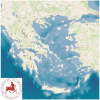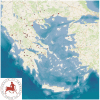Data on Mapping 444 Dairy Small Ruminant Farms during a Countrywide Investigation Performed in Greece
- PMID: 37370554
- PMCID: PMC10295351
- DOI: 10.3390/ani13122044
Data on Mapping 444 Dairy Small Ruminant Farms during a Countrywide Investigation Performed in Greece
Abstract
The small ruminant industry is the most important branch of Greek agriculture. Nevertheless, despite the importance of small ruminant farming for Greece, no detailed mapping of the respective farms has been undertaken and published. The present work refers to mapping the dairy sheep and goat industry in Greece through an extensive, countrywide cross-sectional study, in which information was obtained from 325 sheep and 119 goat farms. The objectives were the collection, the classification and the presentation of data obtained from all these farms through interviews, using a questionnaire and through examination of samples collected during the visits. All the farms enrolled in the study were visited by the investigators. Initially, information was obtained by means of a detailed, structured questionnaire with 442 questions. Moreover, samples of milk were collected from the bulk-tank of each farm and faecal samples were collected from female animals in each farm. The milk samples were processed for cytological and microbiological examination. Staphylococcus spp. and Listeria spp. isolates were recovered and identified at a species level; furthermore, a full antibiotic sensitivity pattern assessment was conducted. Faecal samples were processed by standard parasitological tests for the identification of protozoan, trematode, cestode and gastrointestinal and respiratory nematode parasites. The paper presents the cumulative findings of the study, i.e., the answers to the questions during the interviews and the results of the laboratory examinations performed in the samples; the findings are presented separately for sheep and goat farms. The findings can be used as baseline measurements; individual farms and cohorts of farms can be compared against the current results to draw conclusions against the countrywide situation. Moreover, the current results can be used as reference points for the future, in order to assess changes that might have occurred in the meantime. The study also described the differences between farms with sheep or goats; in total, differences in 137 parameters were identified. Some of these can be attributed to the different management systems practiced; sheep flocks are managed mostly under the intensive or semi-intensive system, whilst goat herds are managed mostly under the semi-extensive or extensive system. These findings can be useful in the health management of small ruminants, in providing evidence-based support and within the scope of precise livestock medicine and health management.
Keywords: dairy; goat; mastitis; milk quality; parasitology; sheep.
Conflict of interest statement
The authors declare no conflict of interest.
Figures














References
-
- Hellenic Statistical Authority Farm Structure Surveys. [(accessed on 12 October 2021)]. Available online: https://www.statistics.gr.
-
- Pulina G., Milán M.J., Lavín M.P., Theodoridis A., Morin E., Capote J., Thomas D.L., Francesconi A.H.D., Caja G. Invited review: Current production trends, farm structures, and economics of the dairy sheep and goat sectors. J. Dairy Sci. 2018;101:6715–6729. doi: 10.3168/jds.2017-14015. - DOI - PubMed
-
- Ministry of Agricultural Development & Food . Greek Agriculture—Animal Production. Ministry of Agricultural Development & Food, General Directorate for Animal Production; Athens, Greece: 2018. p. 16.
-
- Hellenic Agricultural Organisation—Demeter Deliveries of Ovine and Caprine Milk by Region and Regional Authority—Calendar Year 2022. [(accessed on 19 April 2023)]. Available online: https://www.elgo.gr/images/ELOGAK_files/Statistics/ELGO_STATS/1.ΕΛΓO_STA....
-
- Hadjigeorgiou I., Vallerand F., Tsimpoukas K., Zervas G. The socio-economics of sheep and goat farming in Greece and the implications for future rural development. Opt. Méditerran. B Etud. Recherch. 2002;39:83–93.
LinkOut - more resources
Full Text Sources
Miscellaneous

